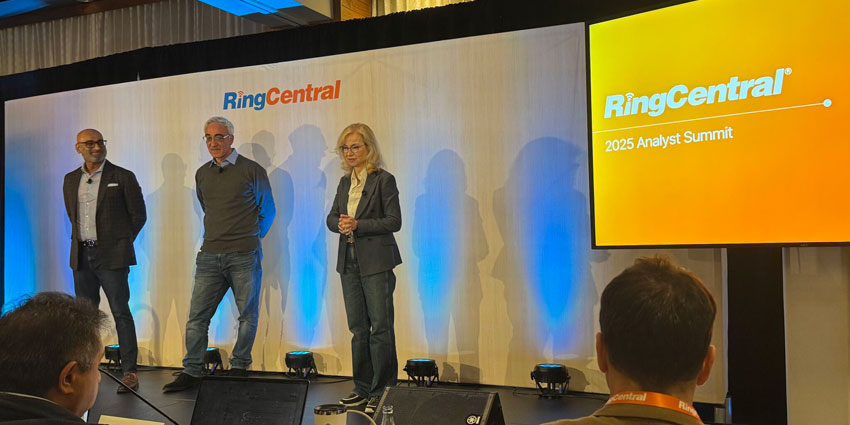Last week, RingCentral held its annual analyst summit in Napa Valley.
While this event, and ones like it, set the stage for vendors to provide a look at where their products are and what the roadmap looks like, there is also a fair amount of chatter regarding the industry more broadly.
Given this, it’s fascinating to reflect on the keynotes and discussions to consider their implications.
Below are five key takeaways from the event.
1. AI Pricing Is Still in Flux
One question that comes up at every analyst event is: how will AI services be priced?
Currently, that question appears to have no answer. Vendors have suggested they are currently looking at per-seat, utilization, and even outcome-based pricing.
At the event, Kira Makagon, the newly appointed President & COO of RingCentral, highlighted that while utilization-based pricing might seem simple, there are several complications.
From a customer perspective, it would turn contact center pricing from predictable to unpredictable.
Also, defining “utilization” isn’t trivial. By the message? Character? Conversation? Minutes? There are many options.
Makagon said the company is leaning towards bundles. For example, customers could purchase a certain number of minutes for a virtual agent and then pay an overage charge if exceeded.
Yet, ultimately, many vendors will likely offer multiple options to meet the demands of different types of customers.
2. In CX, Voice Is the New Text
Those with many years of experience in communications may remember Cisco pitching the concept of “video being the new voice.”
Eventually, that happened as knowledge workers use meeting technology far more than phones, although it did take a pandemic to get there.
In the CX space, there has been a shift from voice to messaging, as IVRs and voice automation provided a less-than-stellar experience.
As such, instead of beating their heads on the wall screaming “agent”, many consumers shifted to messaging apps.
Yet, with virtual agents, such as RingCentral’s recently announced AI Receptionist (AIR), the quality has gotten so good that voice seems set to return to the preferred interface.
The AIR demo from the event was good, although there was too much latency in the interactions, which the RingCentral team acknowledges with the promise it will get better faster.
Nevertheless, look for voice to surge in contact centers. Eventually, every app and most devices will be accessible through a voice interface.
3. The Rebirth of Voice Plays to RingCentral’s Core Strength
While the communications landscape is crowded, many vendors are best known for a specific aspect of the overall technology spectrum.
For example, Zoom is a video vendor with a growing voice business first. Microsoft Teams is a great chat application, but its voice and voice capabilities are still maturing. RingCentral came to market in 1999 as one of the first cloud voice providers.
At that time, the market was still in doubt, and RingCentral’s reliability was spotty.
Since then, the company has invested heavily in all aspects of communications but has created an ultra-reliable and secure voice platform.
Voice re-emerging as the preferred channel will play to RingCentral’s strength.
4. Contact Centers Need New Metrics to Measure Effectiveness
Anyone in the contact center industry is aware of legacy metrics such as average handle time (AHT) and first call resolution (FCR). Such KPIs have helped businesses understand how to direct contact center investments.
In the AI era, these metrics may not be the right ones to measure.
For example, AHT is widely used to measure contact center effectiveness. The shorter the call, the better.
However, with AI, virtual agents should handle mundane and repetitive tasks, such as password resets and account lookups, leaving more complex calls for humans. As this happens, AHT could go up. Across many businesses, this has happened.
Also, agents are shifting from reactive support people to a function expected to upsell customers. All of this leads to longer but more strategic calls.
As such, companies should focus on customer-experience-led metrics, such as NPS score, agent upsell, and agent engagement.
5. The “Target Agent” Approach by RingCentral Is the Right One for Virtual Agents
While many vendors have unveiled various virtual agents, RingCentral’s announcement stood out.
Most of the previous releases have been generic “agents”, leaving the customer to figure out how to best leverage it.
The focus on a “receptionist” demonstrates its value with a job function many companies want to do away with.
Many companies would prefer not to backfill receptionists as hybrid and remote work has reduced the need for in-person greeters, making AIR an ideal replacement.
Also, it’s a low-risk way to try the product out. If a sales agent quotes an order wrong or a service agent sends the wrong product, that could have big implications for customer satisfaction.
With AIR, if the wrong address or store details are given out, it may annoy the customer but should not cause long-lasting friction.
Moving forward, I’d like to see more targeted use cases for agentic AI, virtual agents, and other AI technology, as it’s much easier to prove the value if one understands what job function to focus on.
Final Thoughts
It was a strong event for RingCentral, but there is some urgency for the company.
The UCaaS and CCaaS landscapes are becoming increasingly crowded due to significant overlap in the two product areas.
At $2.5BN in revenue, RingCentral is one of the bigger competitors but not so compared to Cisco Webex, Amazon, Microsoft, and even Zoom, which is now over $4B in revenue. T
As such, its targeted execution – with products like AIR – has become important, as has its ability to capitalize on voice.
The addition of Makagon as President and COO should help the company accelerate its product roadmap and go to market, as she and CEO Vlad Shmunis have a long, trusted history together. More to come, I’m sure.







